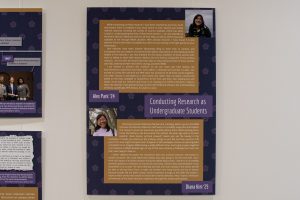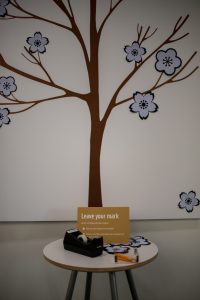At the very front of Earl Gregg Swem Library, a display of historical images tells the story of the first Asian American women who attended the College of William and Mary.
Created by Diana Kim ’25 and Alex Park ’24, the Charting Diverse Pathways exhibit aims to promote visibility for the Asian Pacific Islander and Middle Eastern community at the College. The exhibit tracks the lives of the first three Asian American women to attend the College: Hatsuye Yamasaki Kajiwara ’37, Margaret Lee Masters ’45 and Beatrice Fujiwara Sakai ’53.
Kim and Park follow the research started in the 2021-22 academic year during the College’s Asian Centennial. The Asian Centennial celebrated the 100th anniversary of the first student of Asian ancestry to attend the College, P.K. Chen, Class of 1923. Park noted the significance of its celebration to her as an Asian American student.

“As an Asian American person on campus, it felt like a very big deal because it was the first time that any of these communities that I’ve been in, especially in predominantly white spaces, we got to see ourselves represented and people like us honored in that way,” Park said.
Sumie Yotsukura ’22 and Brian Zhao ’23 led the research focused on P.K. Chen, and Director of the College’s Asian Pacific Islander American department Professor Deenesh Sohoni supervised their work. For Sohoni, the Asian Centennial boosted visibility that helped create the College’s Asian Pacific Islander and Middle Eastern Research Project, under which Kim and Park’s project falls.
“One of the big things that both [Professor Francis Tanglao-Aguas] and I wanted to do was not just some big celebratory events, but also to create something that’s more sustainable,” Sohoni said. “And so right now we have this kind of nebulous entity, the APM Research Project, where it’s the sustainable part of the centennial. The centennial was one year, but we want to create opportunities for students to conduct research about Asian-American experiences. And that’s what Diane and Alex did over the summer.”
Using funding from the Charles Center and the Braitmayer Foundation fellowship, Park and Kim began their research. They started in Swem Special Collections, looking at historical views of Asian Americans with archivist Jennie Davy. Their goal was to understand the social and racial environment and attitudes at the College during Yamasaki Kajiwara, Lee Masters and Fujiwara Sakai’s respective decades.
“[These women] each had different experiences at William and Mary,” Park said. “Something of note is how far spaced apart they are. There’s almost a decade in between the entrance of each woman….contrary to when we talked about the first….women to be accepted to William and Mary, there wasn’t a huge change. You didn’t see a flood of Asian students coming in. You didn’t see any notable changes happening within the community. And it really takes looking at a larger time period and all three of those women to start to understand why that would happen.”
From there, Park and Kim conducted oral history interviews. Reaching out to Lee Masters’ family and Fujiwara Sakai’s family, they were able to speak to Katherine Masters, Lee Masters’ daughter, and get an account from Fujiwara Sakai herself.
“Getting that history and hearing Beatrice’s life and story through her words, not the words of government records and all of that stuff, was so cool, because it’s little things,” Park said. “She talks about how much she loves Virginia ham. It’s little things like that that ended up not making it into the exhibit just because of space and everything, but as the researcher and having spent so much of my time looking into their lives is cool.”
For Kim and Park, their work was highly collaborative.
“We’re always geeking out in some way of the new information that we learned about our people,” Kim said. “When we had a moment of like, ‘oh my goodness, we found something,’ it’d be like we share it on email, we texted to each other, like ‘I found something’….It’s always collaborative. It’s almost like you’re private investigating partners, trying to figure out a person’s life.”
In addition to their team collaboration, Park and Kim also worked with external agencies to expand their audience. Working with groups such as the 1882 Foundation and School of Education Professor Dr. Esther Kim, the team plans to convert their research into educational materials. The K-12 Asian American Studies Education Initiative will provide educators with more resources about Asian American history and representation.
“We’re taking the local histories that we research, so P.K. Chen, Art Matsu Hatsuye, Margaret and Beatrice,” Kim said. “We take their stories, and we contextualize it into history lesson plans so that public educators in Virginia can use it. So when you talk about the Chinese Exclusion Act, they have a local story to tell students, like how P.K. Chen was at Williamsburg. And during the Chinese Exclusion Act, Margaret came through Angel Island, which was an immigration office. And she was able to come to the United States, despite the Chinese Exclusion Act as well.”

Sohoni plans to further the APM Research Project by looking at different minority populations. Plans already exist to investigate the first faculty of Asian descent at the College.
“We added the different stories, and like I said, it was the first male international students,” Sohoni said. “So now we’ve done women, but there’s stories about the first Asian Indians. There’s the first stories of the first Muslim students and so forth. And so we wanted to make sure that we keep expanding their representation because there are a lot of these stories that can be told and they’re important stories. And I think that this project is raising that issue…. I think that we’re on the cutting edge of bringing that awareness to opening up the histories of Asian-Americans at William and Mary.”
Park hopes the exhibit reminds Asian American students that they are not alone on campus.
“A lot of the representation and existing and taking up space on this campus has fallen to the students themselves, especially [multicultural organization] exec boards, a huge chunk of the responsibility that comes with trying to exist at a predominantly white school,” Park said. “So I think, looking at this exhibit and looking at these experiences of three women, for Asian Americans at the school and Asian people, we’re saying that you belong here, you take up space. There’s a huge history that we haven’t explored here, but that has led to you being here and you deserve every single moment with that.”
The exhibit will remain on display in Swem’s entrance gallery until mid-April 2023.

